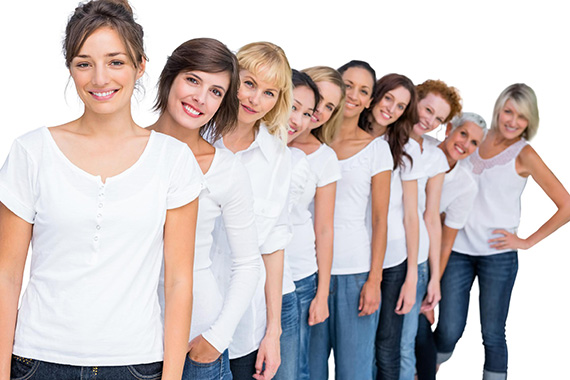1. Work with real people
In an effort to reduce costs and boost the authentic appeal of an image, it has become increasingly common that real people (as opposed to professional talent) be used for stock imagery productions. One advantage is that real people are more likely to be willing to sign model releases since they often have a greater return-benefit interest in receiving professionally crafted images of themselves.

photo by Wavebreakmedia Ltd
Because real people often have little prior on-camera “in the lime light” experience, it is important to screen these potential models wisely. Asking open-ended questions during the casting process can provide insight as to the personality of the individual and their willingness to interact with others. Sharing images of prior shoots with the potential model can assist in managing their expectations and increasing their confidence and willingness to participate.
2. Manage who attends the photo shoot
Because of the risk-taking involved and unknown nature of participating in a commercial lifestyle photo shoot, people tend to ask if they can bring extra people to attend with them. In order to shoot dynamics, it is often helpful if close friends and family of the models are not present (unless models are under age 18). The reason for this is psychological, as the person who is modeling can often feel an obligation to speak with or entertain the non-participating extras. In an effort to allow the model to feel free and detached from the necessities to perform, while also increasing their natural interaction with others, it is suggested that models be encouraged to attend the photo shoot alone.

photo by Kamil Macniak
3. Increase confidence before and during the photo shoot
It is important to assist the potential model with an understanding of what the photo shoot is about and who else will be there. Providing a “what to expect” guidelines sheet in the form of a PDF that is emailed before the photo shoot can be very helpful. This sheet can include photos of the team members who will be present, the location, wardrobe ideas, and a list of how the process will unfold. The orientation process might include what types of conversations will be taking place on set, who will be supporting everyone with directions, and reasons for why the images are organized in the creative structure as they are. This guideline is similar to the industry specific “call sheet,” but should go beyond factual details of time, place, and contact information. People are more likely to be willing to devote time and energy to a project when they understand the full parameters of what their participation means to the outcome.

photo by Christian Bertrand
4. Designate a model “wrangler”
Choose someone—or designate yourself—to be the introducer, initiator, and moderator of communication between models on the shoot day. It’s not uncommon for models, especially real people at a first-ever lifestyle photo shoot, feel initially shy. The wrangler’s job is to keep the conversations going; this requires emotional sensitivity to the needs of the models to feel warmly invited to the photo shoot and shooting process. It may involve helping to get snacks and water for models and any other specific special needs that they might have. It should also involve seeding conversations to help break the ice with humor and contemporary knowledge of news events and/or other collectively shared experiences in order to provide models with the opportunity to have real and natural interactions for picture making purposes.

photo by Antonio Guillem
5. Provide snacks or special food and drink
Just as business meetings are more comfortable and relaxed when done over dinner, consider making the shoot experience more pleasant for models by introducing special treats. It could be seasonally relevant fruit, sweets from a nearby popular bakery, or a bottle of white wine (to avoid stains to clothing and upholstery). When food and drink are present, models are more likely to stick around for a while and get to know each other, bond, and be conducive to natural interactions when the photo shooting starts.
6. Scout the location environment in advance
The photographer’s sense of confidence is just as important as the models’. By visiting the location ahead of the shoot, one can creatively and logistically digest how the shoot will take place. This confidence will breed efficiency on the shoot day—anything from knowing where the bathrooms are, to how to turn on the lights or where to park the car. Often scouting the location before the shoot day can bring new ideas to mind that would otherwise be missed or not prepared for. Location scout photos might also be relevant to the shoot project and be licensable as stock images.

photo by lzf
7. Wear comfortable work clothes
The more comfortable you are in moving about quickly and easily, the more comfortable and creative you will be during the shoot. Having a proper hat, layers of clothes, shoes, and accessories like sunglasses, sunscreen, gloves, or even kneepads, breeds an ease of accessibility to make interesting photos from unique hard-to-obtain angles. If you’re wearing the proper clothing, you will be more encouraged to trudge through the snow, stand in the mud, shoot from overhead, or crawl around from below—things that might make or break the perfect shot.

photo by Olesia Bilkei
8. Overbook models
Not every model will live up to expectations while on set. Sometimes people simply have a bad day or interact better in different group dynamics. Overbooking models allows for a cost-effective way to time manage the process of last minute, and inevitable, cancellation by a certain percentage of the talent. It also hedges a bet for the shoot concept in risk protection should a particular model not be performing as expected and need to have their role exchanged for a while by another model who is attending.
9. Make formal introductions
Easily forgotten, a formal “stop in the action” introduction of each new attendee to the shoot helps to not only increase the group cohesion, it is a one-time-only efficient way to let everyone know who everyone else is. A formal announcement of the models attending is respectful and polite to their time and energy and makes them feel as not just another face in the crowd. People enjoy being known by name and knowing that others know who they are.

photo by Photographerlondon
10. Turn off smartphones
Easily the most distracting aspect on set these days is the smartphone and constant “check-in” to smartphone apps. Encourage people to put their phones to the side so that conversations might be had with each other instead. This will not only produce better cohesion, but will also increase attentiveness by those who are modeling and/or attending to the models.

photo by Cleardesign
The suggestion can be framed by the reality that the more interpersonal the interaction is between those on set, the more likely they are to establish longer-term friendships with each other. Keeping cell phones in Airplane Mode will help encourage this process of networking and will improve the group rapport.
About the Author:
Shannon Fagan is a professional stock photographer for Dreamstime.
Like This Article?
Don't Miss The Next One!
Join over 100,000 photographers of all experience levels who receive our free photography tips and articles to stay current:






Leave a Reply